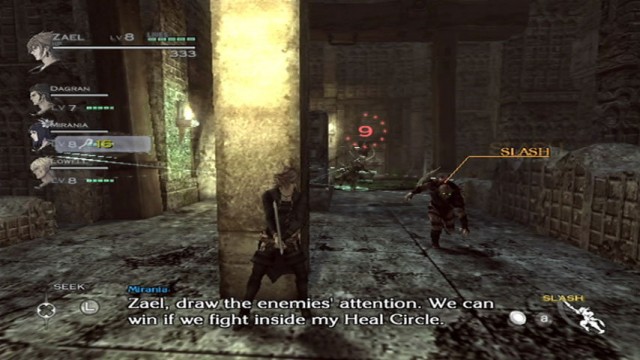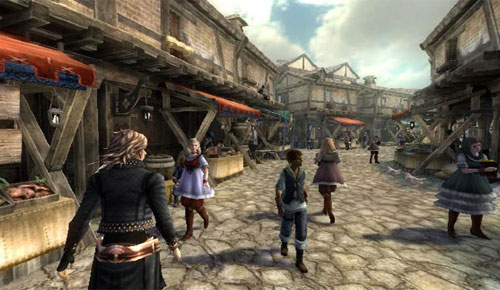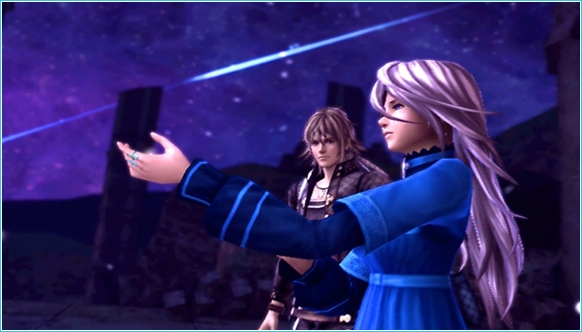Beautiful score, engaging and strategic battle system, close and intimate plotlines and character relationships.
Several missed opportunities for added gameplay sequences, slightly messy auto-targeting, an occasionally inflexible camera, and an ending that came all too soon!
There’s something to be said for Operation Rainfall. While it brought a lot of attention to three Japanese RPGs we all thought would never see the light of day in Europe and the US, it also revealed just how dedicated fans are to the genre. We owe everyone involved for helping spread word– and secure the release– of these games.
At the same time, however, I can’t help but feel like The Last Story has been rather unfortunate in its two bedfellows. Having been placed alongside Xenoblade Chronicles and Pandora’s Tower for the best part of a year, it’s inevitable that comparisons are going to be drawn. And in the case of The Last Story, it’s sometimes to its detriment.
So let’s get this out of the way now– The Last Story is not Xenoblade Chronicles. I can’t speak for Pandora’s Tower yet, but whereas Xenoblade was an epic in every sense of the word, with vast, overwhelming landscapes and a long and enthralling story to match, The Last Story tells a much more intimate and personal tale that’s almost fleeting in its brevity. But while it may be less ambitious in its scope, that doesn’t mean it’s any less charming or appealing. It sets out to achieve something entirely different from Xenoblade and, as we’ll soon see, it does so rather admirably.
Set on the beautiful Lazulis Island, you play as Zael, a young mercenary aspiring to become a knight. Standing in the way of his dream, however, are the Gurak, an exiled people who want to reclaim Lazulis Island for themselves, and Zael and his companions must join forces with the island’s ruler, Count Arganan, to try and halt the invasion. They’ll face several opponents both within and without the Castle walls as they work to gain the count’s favour, but Zael soon learns that there’s something else lurking in the depths of Lazulis Castle that could end up destroying much more than just the Gurak. With Count Arganan set on going to war, Zael must make a decision: either fulfil his dream and win the chance to marry the girl he loves, or give it all up to save the lives of thousands.
It’s not the most original plot in the world, it has to be said, and it revisits many themes like world decay and technology abuse which have been popularised by the Final Fantasy series. But no matter how familiar the subject matter may be, The Last Story works hard to set itself apart from its spiritual ancestor right at the get go. Within seconds of starting up your game, you’re thrown straight into battle and introduced to the game’s excellent combat system. Taking place in real-time, strategy is absolutely key here, emphasised all the more by the top-down field overview each time a new battle begins, showing you the locations, levels and types of enemy you’ll be facing. Your friends will give you helpful hints and tips about where to start too, like taking out the long-range mages first or using your crossbow to tempt stronger enemies away from the crowd. The variety of enemies aren’t particularly extensive, but no two encounters are exactly the same– the terrain, layout and amount of available cover are always different– and when your party members are constantly falling in and out of attendance as well, there’s plenty to keep you on your toes. Moreover, each character may have five lives at their disposal, but you’ll soon find that number depleting rather rapidly if you simply go in guns (or rather swords) blazing. Dodging, defending and taking advantage of your mages’ spell circles are far more important than mere brute force in this game, and it’s back to your last checkpoint once your five lives are up.

If you can get to that enemy spell-caster before his countdown reaches zero, you can halt his attack.
Overall, it makes for a very dynamic and unique battle system, which is made all the more interesting by Zael’s handy “Gathering” ability. This allows him to draw enemy attention away from your mages and spell-casters, as well as lead them to certain parts of the battlefield if necessary. He can also revive “downed” allies by touching them when it’s activated, which is often a lot quicker than waiting for them to do it automatically. At first I feared this would mean Zael wouldn’t be doing much attacking of his own, but that certainly wasn’t the case. On the contrary, he’s just as important in taking down enemies as the rest of your team– you’ve just got to be careful about how often you let your guard down as big attacks can easily wipe out one of your lives.
However, Gathering also comes with its own flaws; by making yourself the centre of attention, it’s very easy to get surrounded and have several enemies attacking you at once. While this is all part of Gathering’s strategy, it’s considerably more difficult to pick or switch your intended target, and this is something Xenoblade handles much more effectively. Pressing the analogue stick toward a certain enemy will make Zael attack automatically, but it’s rather hit and miss if he swings his sword at your intended target. The camera also becomes a bit of an enemy during these tight spots, especially in narrow corridors, as it frequently never seems to swing round quite far enough to let you see any possible escape routes. Similarly, Zael is rooted to the ground when you enter first-person mode to fire his crossbow, meaning that if you’re not positioned just right then you have to get up and maneuver yourself again rather than simply creep a bit to the side to adjust your view. So much for those stealth attacks, then.
Speaking of missed opportunities, there were also several moments in the game which, given the chance, could have made brilliant additional gameplay sequences had they not been simply narrated over at the end of every chapter. To give an example, Zael has to sneak out of Lazulis Castle at one point and get back to his friends in the city tavern. Guards are looking for him everywhere, but once we reach the castle gates the chapter ends and the narrator just tells us he made it back safely. If we’d been allowed to make our own way there, it not only could have extended a relatively short chapter, but it also could have made for a potential chase sequence around the city (especially given the fact that Zael can look over his shoulder and glance behind him while walking around town). The single-player quest still clocks in at a respectable 20 to 25-odd hours, but it felt like there could have been so much more at our disposal if we had actually been allowed to play more of the story that we were being told.

Lazulis City is a hive of activity with several hidden secrets for curious players.
That said, there’s an incredible amount of detail packed into the rest of the game’s story, and it’s definitely these added personal touches which make The Last Story really shine. Lazulis City may be the game’s only central location, but it’s a thriving and vibrant metropolis brimming with children playing in the squares and people going about their daily business. As you pass certain citizens you’ll hear snippets of conversation about people disappearing by the mansion in the north of town, or a pair of washerwomen chatting about Reptid sightings near the wells in the city’s backstreets, and it makes the whole town feel alive and full of character. If you eavesdrop on people too long, they’ll even catch you staring and tell you to mind your own business. You’ll also get lost several times as you take a wrong turn or three down a winding alleyway, but when hidden items await around nearly every corner, you’ll want to leave no stone unturned as you explore every last nook and cranny Lazulis City has to offer.
There are also a number of additional quests waiting for you if you’re willing to look for them. I hesitate to use the word “sidequest” as many of them aren’t really something you can do “on the side”– rather, several of them are full-blown story chapters each with their own boss, location and story arc. Completing these unlocks rare items and additional features in the city, and you’ll also be able to return to them at a later date to try your chances against stronger monsters and find even rarer treasure.
But it’s not just Lazulis City which shows off the game’s personality, as each quest (main and “side” alike) also exhibits an equal amount of individual charm. For example, it’s not unusual for Zael and his companions to often share little anecdotes (in a range of well-executed regional accents to boot) as you saunter through the island’s caves and tunnels, and it’s the little details like Mirania wondering how fried kraken tentacles might taste, or Syrenne’s desperate cries for alcohol, which really help endear them to the player and make them feel like one of the gang. Mercenaries may not be looked upon too kindly on Lazulis Island, but you’ll find it hard not to like them as you listen to their warm and friendly banter. It’s far more effective than making the player watch long cut-scenes to introduce them all, but the only problem with such talkative companions is that their dialogue often gets cut off if you run too far ahead or unwittingly enter the next area before they finish. This means you’re better off standing still if you want to hear the whole conversation, which rather defeats the point– you may as well just watch a cut-scene.

Cut-scenes are plentiful, but often let you interact via a first-person viewpoint and never outstay their welcome.
But The Last Story isn’t all about the single player mode– there’s also multiplayer to get stuck into as well. Comprising of two modes, Deathmatch and Co-op, the former evens out your levels and upgrades to pit you against other players, while the latter allows you to keep your levels and upgrades and team up with five other players to take down former bosses. But be prepared as the Co-op bosses are much, much stronger than those you face during the main game, and I barely even made a dent in them at Lv.60. To fully enjoy this mode, you either need a full roster of players behind you, or some very, very high-levelled characters to pull you through. Overall, it’s a nice add-on, and certainly worthwhile for those hungry for rare items and willing to put in the effort for them, but new players may find it rather daunting.
All in all, The Last Story is simply a delightful game to play. With its rich, lively combat system and entertaining characters, it strikes a masterful balance between engaging gameplay and heartfelt story-telling. It isn’t perfect by any means, and it may be more linear than its Operation Rainfall counterparts, but never has linearity felt more satisfying and personal. It’s been a long time since JRPGs have felt so human and down to earth, and when the whole package is scored by Final Fantasy maestro Nobuo Uematsu, you would be doing yourself a great disservice by missing out. It may be the last story on Wii by the time it gets released in the US in June, but this is one game you won’t want to overlook.




 ShareThis
ShareThis






